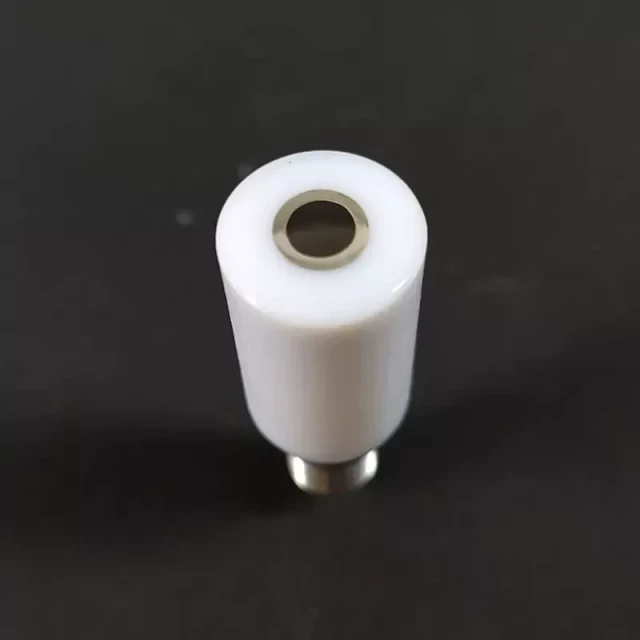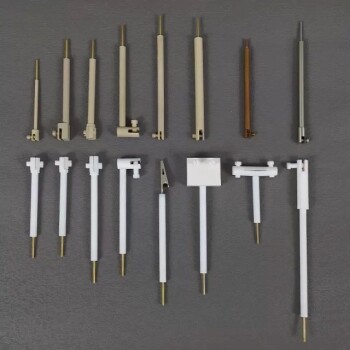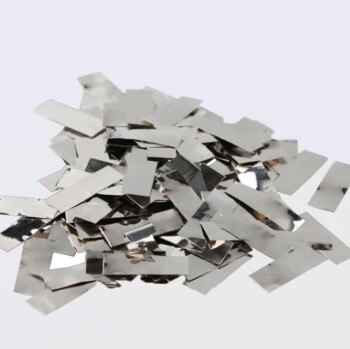Introduction to Rotating Ring-Disk Electrodes
Rotating ring-disk electrodes (RRDE) are widely used in electrochemical research to study electrocatalytic reactions. They consist of two electrodes - a rotating disk electrode (RDE) and a stationary ring electrode (RE) - combined in a single assembly. The RDE generates a radial diffusion gradient, while the RE collects the products of the reaction. The RRDE technique allows for the determination of the reaction mechanism, kinetics, and selectivity of electrocatalytic reactions. RRDEs are used in a wide range of applications, from fuel cells to sensors, and they require careful selection of electrode materials for optimal performance.
Table of Contents
Importance of Electrode Materials
Electrode materials play a crucial role in determining the accuracy and reliability of electrochemical studies using rotating ring-disk electrodes (RRDEs). The choice of electrode material should be based on the specific electrochemical system being studied and the properties required for accurate and reliable results.

Factors to consider in choosing electrode materials
Electrode materials with good conductivity, stability, and reproducibility are preferred. Platinum is one of the most commonly used electrode materials due to its high conductivity and stability in various electrolytes. However, its high cost makes it less desirable for routine use. Other electrode materials such as gold, carbon, and glassy carbon are also commonly used due to their good conductivity and low cost. However, these materials may not be stable in certain electrolytes and may undergo surface modification during the experiment, leading to inaccurate results.
Importance of electrode preparation and handling
The preparation and handling of the electrode material are also important factors to consider to ensure reproducibility of the results. Electrode materials should be prepared according to well-established protocols and should be handled with care to avoid contamination or damage to the electrode surface.
Impact of electrode materials on electrocatalysis studies
Electrocatalytic studies are another important application of RRDEs. For example, RRDEs can be employed to assess electrocatalyst activity for processes such as the oxygen reduction reaction (ORR), nitrogen reduction reaction, and carbon dioxide reduction. The choice of electrode material for electrocatalytic studies is critical for achieving optimal yields and selectivity in synthetic organic electrochemistry.
Limitations of commercially available electrode materials
While commercial RRDEs are widely available, the electrode selection is typically limited to combinations of more common electrode materials such as gold, platinum, and glassy carbon (GC). Even with these standard materials, RRDEs can be costly, and to extend the range of applications, there is a need to move to different electrode materials.
In conclusion, the selection of the appropriate electrode material is a critical factor in the success of electrochemical studies using rotating ring-disk electrodes. The choice of electrode material should be based on the specific electrochemical system being studied and the properties required for accurate and reliable results. The preparation and handling of the electrode material are also important factors to consider to ensure reproducibility of the results. Finally, the electrode material is an additional parameter that requires optimization, but it can be exploited to control and change the selectivity of a reaction, and provides opportunities to vary reactivity through electrode-catalysis.
Noble Metal Electrodes
Noble metal electrodes, such as platinum, gold, and silver, are commonly used in Rotating Ring-Disk Electrodes (RRDEs) due to their high catalytic activity and stability in various electrolytes. Platinum electrodes are the most widely used noble metal electrodes in RRDEs due to their high electrocatalytic activity towards various electrochemical reactions.

Platinum Electrodes
Platinum electrodes are known for their high electrocatalytic activity towards various electrochemical reactions, making them the most widely used noble metal electrodes in RRDEs. Platinum is a noble metal that exhibits excellent corrosion resistance, high electrical conductivity, and catalytic activity towards various electrochemical reactions. Platinum electrodes are preferred over other noble metal electrodes due to their high stability in various electrolytes. The preparation of platinum electrodes for RRDEs involves several steps, including polishing, cleaning, and activation, to ensure a smooth and clean surface for accurate electrochemical measurements.
Gold Electrodes
Gold electrodes are preferred for the measurement of redox species due to their unique properties. Gold is a noble metal that is known for its excellent conductivity, stability, and biocompatibility. Gold electrodes exhibit excellent electrochemical properties, including low capacitance, high catalytic activity, and high sensitivity. Gold electrodes are also preferred for their ability to immobilize biomolecules and other species on their surfaces, making them ideal for biosensing applications.
Silver Electrodes
Silver electrodes are preferred for the measurement of halide ions due to their unique properties. Silver is a noble metal that exhibits excellent electrical conductivity, stability, and catalytic activity. Silver electrodes are preferred over other noble metal electrodes for their high sensitivity towards halide ions. The preparation of silver electrodes for RRDEs involves several steps, including polishing, cleaning, and activation, to ensure a smooth and clean surface for accurate electrochemical measurements.
In conclusion, noble metal electrodes are essential components of RRDEs, and their selection and preparation are critical for reliable and accurate electrochemical measurements. Platinum electrodes are the most widely used noble metal electrodes in RRDEs due to their high electrocatalytic activity towards various electrochemical reactions. Gold and silver electrodes are preferred for specific applications due to their unique properties. The preparation of noble metal electrodes for RRDEs involves several steps, including polishing, cleaning, and activation, to ensure a smooth and clean surface for accurate electrochemical measurements.
Glassy Carbon Electrodes
Glassy carbon electrodes are one of the most common electrode materials used in rotating ring-disk electrodes. They are highly conductive and have a high surface area, which allows for improved sensitivity and detection limits. Additionally, glassy carbon electrodes are chemically inert, making them suitable for use in a wide range of applications.
Advantages of Glassy Carbon Electrodes
In electrochemical studies of biological and environmental systems, glassy carbon electrodes are particularly useful, as they do not react with biological tissues or environmental samples. Glassy carbon electrodes are also robust and can withstand high temperatures and pressures, making them suitable for use in harsh environments.
Limitations of Glassy Carbon Electrodes
However, it is important to note that glassy carbon electrodes are not suitable for all applications. They can be prone to fouling, which can lead to inaccurate results, and their performance can be affected by the presence of certain chemicals and contaminants. As such, it is important to carefully consider the suitability of glassy carbon electrodes for a particular application before use.
Applications of Glassy Carbon Electrodes
Glassy carbon electrodes are widely used in various electrochemical applications such as corrosion studies, fuel cell research, and catalyst development because of their high sensitivity and detection limits. They are also used in biomedical applications such as biosensors and drug discovery.
Conclusion
Glassy carbon electrodes are versatile and widely used electrode materials that offer many advantages. Their highly conductive and chemically inert properties make them suitable for use in a wide range of applications. However, their limitations should be carefully considered before use in a particular application.
Conductive Diamond Electrodes
Rotating Ring-Disk Electrodes (RRDE) are a type of electrochemical instrument that can be used to study electrocatalytic reactions. Electrode materials are a critical component of RRDEs, as they directly affect the sensitivity and accuracy of the instrument. One type of electrode material that has gained increasing attention in recent years is the Conductive Diamond Electrode (CDE).
What are Conductive Diamond Electrodes?
CDEs are made of diamond particles that are mixed with a conductive material, such as graphite, to create a conductive surface. CDEs offer several advantages over traditional electrode materials, such as platinum. They are more durable, have a wider potential window, and are less prone to fouling.
Advantages of using Conductive Diamond Electrodes
CDEs can be used in a variety of applications, including electrochemical sensing, energy storage, and electrocatalysis. They offer several advantages over traditional electrode materials. For example, CDEs are more durable, have a wider potential window, and are less prone to fouling.
Challenges of using Conductive Diamond Electrodes
However, there are also challenges associated with using CDEs. They can be difficult to fabricate, and the conductive material used to make them can affect their electrochemical properties.
Applications of Conductive Diamond Electrodes
Despite these challenges, CDEs show great promise as an electrode material for RRDEs and other electrochemical instruments. As research continues in this area, it is likely that CDEs will become increasingly important in the field of electrochemistry.
Conclusion
Conductive Diamond Electrodes are a relatively new and promising electrode material for RRDEs and other electrochemical instruments. They offer several advantages over traditional electrode materials, such as improved durability and a wider potential window. Despite some challenges associated with their fabrication and use, CDEs show great promise in various applications, including electrochemical sensing, energy storage, and electrocatalysis. As research in this area continues, it is likely that CDEs will become increasingly important in the field of electrochemistry.
Other Conductive Materials
Apart from traditional electrode materials like platinum, gold, and glassy carbon, other conductive materials are gaining popularity in RRDE studies. These materials include but are not limited to carbon nanotubes, graphene, and conductive polymers.
Carbon Nanotubes
Carbon nanotubes, due to their high surface area and unique electronic properties, show promise as a suitable electrode material for RRDE applications.
Graphene
Graphene, a two-dimensional material with excellent electrical conductivity, has also been used as an electrode material in RRDE studies.
Conductive Polymers
Conductive polymers like polypyrrole and polyaniline offer advantages like tunable conductivity and ease of synthesis, making them attractive for RRDE applications.
Metal Oxides and Metal Nitrides
In addition to these materials, metal oxides and metal nitrides have also been explored as electrode materials for RRDE studies. The selection of the electrode material should be based on the specific application, as different materials have different strengths and limitations.
Overall, the use of other conductive materials in RRDE studies is an exciting area of research that holds promise for future advancements in electrochemistry.
Conclusion
In conclusion, selecting the appropriate electrode material for Rotating Ring-Disk Electrodes (RRDEs) is crucial to achieving accurate electrochemical measurements. Noble metal electrodes, such as platinum and gold, are commonly used due to their high conductivity and stability. Glassy carbon electrodes are also a popular choice due to their low background current and good electrochemical behavior. Conductive diamond electrodes offer exceptional durability and low background current, making them ideal for harsh environments. However, each electrode material has its own set of advantages and disadvantages, and the choice ultimately depends on the specific application.
Related Products
- RRDE rotating disk (ring disk) electrode / compatible with PINE, Japanese ALS, Swiss Metrohm glassy carbon platinum
- Rotating Platinum Disk Electrode for Electrochemical Applications
- Metal Disc Electrode Electrochemical Electrode
- Gold Disc Electrode
- Electrode Polishing Material for Electrochemical Experiments
Related Articles
- Advantages of the Rotating Electrode Method
- Understanding Electrodeposition with Electrochemical Electrodes
- Comprehensive Guide to Rotating Disk Electrode (RDE) in Electrochemical Studies
- Comprehensive Guide to Reference Electrodes: Types, Applications, and Selection Criteria
- The Future of Electrochemical Electrodes












